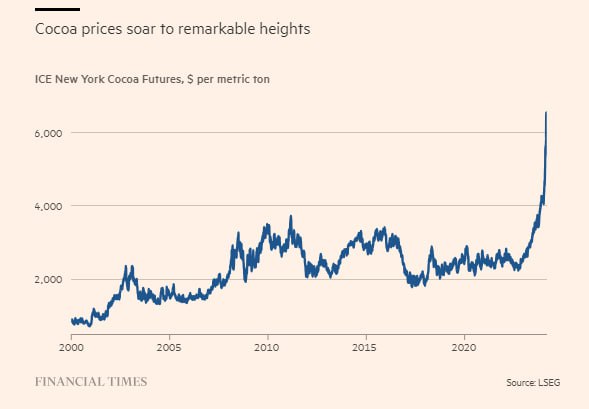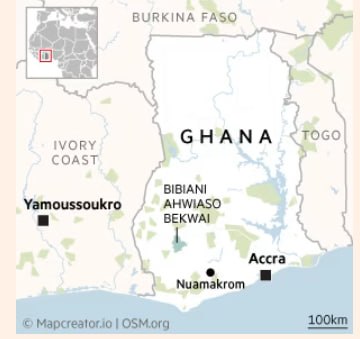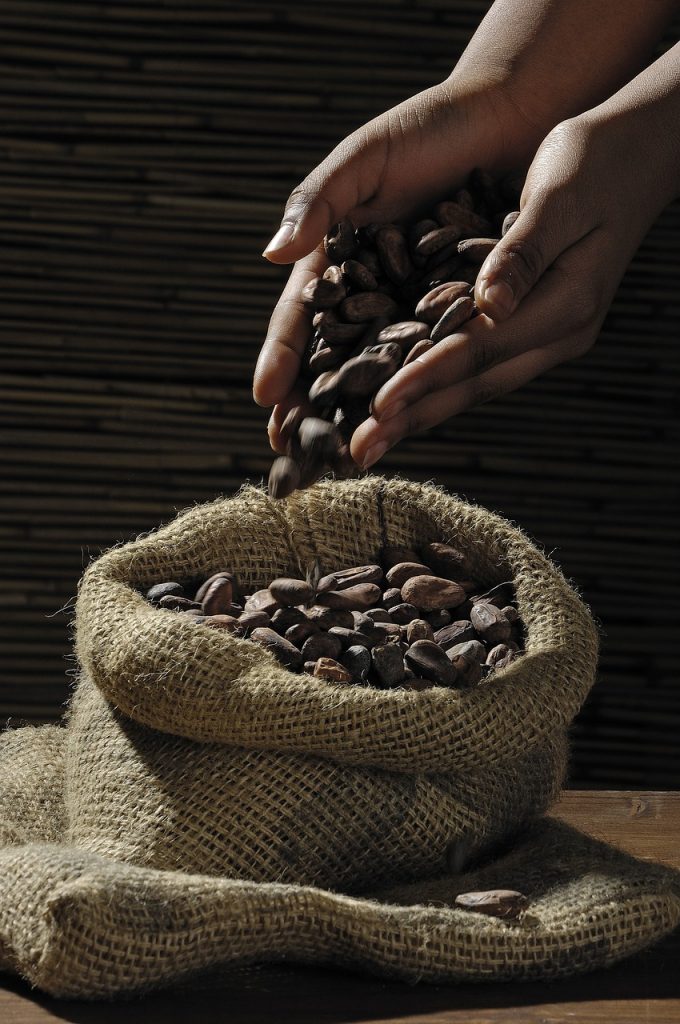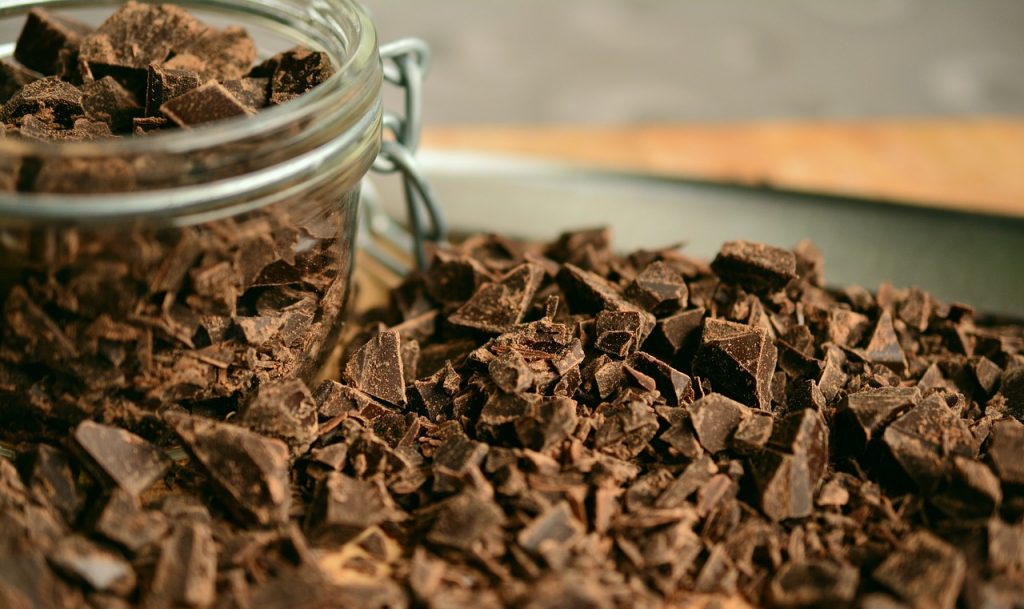
With Easter just over two months away, sweet lovers in Europe and North America are turning their thoughts to chocolate. Tens of millions of milk chocolate eggs will be sold in the UK alone. However, prices this year are expected to be higher than ever before – and this has little to do with current inflationary pressures in the market.
In recent months, cocoa prices have recorded a significant and continuous rise, which has led to an increase in the cost of chocolate. Cocoa bean prices have risen to all-time highs, with New York cocoa futures doubling compared to the same time last year. Cocoa futures traded in London on Tuesday at a record high of £5,827 per tonne. On the same day last year, it was trading at £1,968. In other words, we are talking about tripling the price within a year!
Cocoa: High prices lead to chocolate shortages around the world
El Nino
Prices are rising partly because of limited supply. Bad weather in Ivory Coast and Ghana, which together produce about two-thirds of the world's cocoa beans, has affected crop productivity. Last year, El Niño, a warming sea temperature phenomenon that occurs every three to five years, returned, first bringing unusually heavy rains to the region, then heat and drought. The result is that the global harvest is 11% lower than last season, according to forecasts published by the International Cocoa Organization on Thursday.
Analysts warn that chocolate producers and companies in the industry will pass on the high cost of raw materials to consumers. If they haven't already, they will limit losses by reducing product volumes and boosting prices, says Paul Jules, cocoa analyst at Rabobank. Regular chocolate bars will also likely be replaced with fruit and nut bars or other less chocolate-intensive alternatives, he said.
Perhaps this will not be a temporary situation. While El Niño has played a catalytic role in rising cocoa prices, and market speculators have ruled out further rise as evidenced by the rise in futures contracts, deep-rooted structural issues are supporting production pressure. From climate change to chronic underinvestment, these problems will not be solved by changing times.
Change the model
This model needs to change, says Douglas Lamont, CEO of Tony's Chocolonly, a sustainable chocolate brand that pays farmers a living income premium as a measure to avoid lower returns.
For cocoa farmers like Isifo Isaka, watching the market soar is shocking. Cocoa futures were trading in New York on Monday at $6,648 per ton. He said Isaka gets $1,700 per ton.
Faced with rising input costs, bad weather and disease, yields on his 11-hectare land in Bibiani Anhuyaso Bekwai in western northern Ghana have declined in recent years. “If care is not taken, within the next five years, the world’s second-largest producer will see its production halved,” he says.
Years of massive cocoa production, especially in neighboring Ivory Coast, which produces nearly half the global supply, has kept prices generally low. This may be good news for Western consumers, but here it meant that farmers with limited income were unable to invest in their cocoa farms.
Most have not planted new trees since the early 2000s, and cannot use fertilizers or pesticides. As trees age, they become less productive and more susceptible to disease and bad weather.
Last year brought both. The swollen stem virus has spread to all cocoa farms in the region. The only cure for this is for farmers to uproot their trees. In addition, black pod disease, a fungal infection that causes cocoa pods to rot, has thrived in the moisture generated by last summer's heavy rains.
“The trees are at the end of their lives,” says Nana Arufi Kuram, head of the Noamakrom District in Twifo Ati-Morkwa District, which has 3,000 hectares of cocoa plantations, grown mainly by tenant farmers.
Some of the trees were planted when his grandfather and then his father owned the land in the 1960s and 1970s.
The humid weather of that time has now given way to hot, dry conditions, bringing other problems to sensitive cocoa trees. “The trees are stressed, and the leaves are turning yellow,” says Coram, explaining that this reduces the yield.
He blames climate change. “It rains now outside the rainy season,” Coram says. “Dry seasons are warmer than they used to be.”
He says new seed varieties are more resistant to such changes, but as the impact of climate change accelerates, cocoa farmers don't have the money to adapt. Coram adds that many young farmers in Ghana are abandoning cocoa for easier crops like cassava.
The European Union is trying to deal with such issues. New rules banning the sale of cocoa within the European Union, along with other products grown on deforested land, will come into force at the end of this year.
But the law does not specify who should bear the costs of compliance, and the risk is that already poor farmers will be asked to pay these costs.
Double the demand
At the same time, the world's appetite for chocolate is growing. Demand for cocoa has doubled in recent decades, resulting in a huge deficit. Demand is expected to exceed supply by more than 370,000 tons this year, according to forecasts by the International Cocoa Organization.
A shortfall is only significant if it moves the inventory-to-consumption ratio — the amount of inventory in the world versus total consumption — “which is very influential,” says Nico Debenham, managing director of Sustainability Solutions, which advises companies.
Debenham, who was previously head of sustainability at Barry Callebaut, the world's largest chocolate company, adds that the ratio is now 31.4%, which is prompting commercial players to start buying more and more, driving up prices.
He says small businesses will struggle to get ahead. “You need twice as much to do the same work.”
Even top players feel the pressure. Barry Callebaut announced last week that it plans to cut 18% of its workforce. Hershey also announced plans to cut its workforce by 5% after announcing an 11.5% year-over-year decline in its profits in the fourth quarter of 2023.
Perhaps all this development could be an occasion for change. This is “a big moment for the industry.” [δεσμευτεί να πληρώσει περισσότερο τους αγρότες] Because the price [καταναλωτή] “It's really gone up,” Lamont says. Instead, he fears that when cocoa prices finally fall, they will simply reap huge profits.
The danger is that this situation links the world to a future in which chocolate becomes a luxury product and farmers in West Africa literally struggle to survive.

“Avid problem solver. Extreme social media junkie. Beer buff. Coffee guru. Internet geek. Travel ninja.”









More Stories
Used Car Travels Around The World – Crashed, Sold For New Car
If it weren’t for the merger of Attica Bank and Bankritia, they could have collapsed.
Debt: When will it return to 60% of GDP – “Snowball” Stournara and the Greek Bell